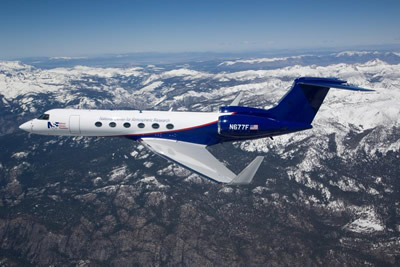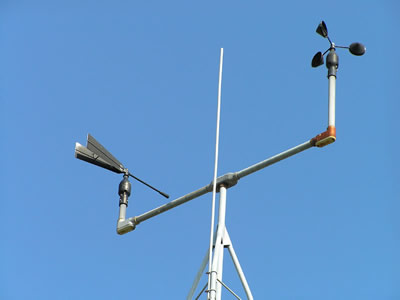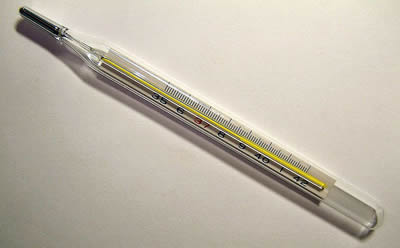This cup anemometer measures the wind speed, and the wind vane on the left side of the image measures the direction the wind is blowing.
Click on image for full size
Image courtesy of NOAA
Anemometer
An anemometer is a weather instrument used to measure the wind (it can also be called a wind gauge). These instruments can be used in a backyard weather station or on a well-equipped scientific research vehicle.
Before there was a standard way to measure the wind, people used phrases like "strong wind" or "soft wind" to describe the wind. In 1806, Sir Francis Beaufort of the British Navy made the first formal measurements of the effects of wind on the ocean, called the Beaufort Scale. In the 1970s, Dr. Theodore Fujita of the University of Chicago created the Enhanced Fujita Scale, which covers the high winds found in tornadoes and severe hurricanes.
Trees can also help us determine the wind speed. For example, with a calm wind leaves on a tree don't move, with a moderate breeze the small branches move, and with a strong gale whole branches break off trees.
You might also be interested in:

Wind is moving air. Warm air rises, and cool air comes in to take its place. This movement creates the winds around the globe. Winds move at different speeds and have different names based on their speed.
...more
Hurricanes form in the tropics over warm ocean water. The storms die down when they move over land or out of the tropics. At the center of the rotating storm is a small area of calm weather and clear skies
...more
Rainbows appear in the sky when there is bright sunlight and rain. Sunlight is known as visible or white light and is actually a mixture of colors. The sun's rays pass through millions of raindrops. A
...more
It takes the Earth one year to travel around the sun one time. During this year, there are four seasons: summer, autumn, winter, and spring. Each season depends on the amount of sunlight reaching the
...more
Scientists sometimes travel in airplanes that carry weather instruments in order to gather data about the atmosphere. These research aircraft bring air from the outside into the plane so scientists can
...more
An anemometer is a weather instrument used to measure the wind (it can also be called a wind gauge). These instruments can be used in a backyard weather station or on a well-equipped scientific research
...more
Thermometers measure temperature. "Thermo" means heat and "meter" means to measure. You can use a thermometer to measure the temperature of many things, including the temperature of
...more














